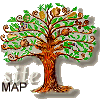
Figure 7A
Detail of field notes (reference Figure 1) for grid type survey for production of floor plan.

Figure 7B
Detail of field notes for elevational view using grid survey technique. Direct method is similar.
FIELD SKETCHES
 The process of hand measurement starts with the drawing of freehand sketches. These sketches define the form and provide the framework for recording of dimensions and notes. Additionally they serve as studies in how best to illustrate any particular feature (e.g. choice of view and scale). The ability to sketch quickly and accurately is a great asset that is developed with constant practice. Particularly well drawn sketches can be almost as useful as the finished drawings. The process of hand measurement starts with the drawing of freehand sketches. These sketches define the form and provide the framework for recording of dimensions and notes. Additionally they serve as studies in how best to illustrate any particular feature (e.g. choice of view and scale). The ability to sketch quickly and accurately is a great asset that is developed with constant practice. Particularly well drawn sketches can be almost as useful as the finished drawings.
|
 |
 These sketches form part of the permanent survey record, and should be drawn on single-sided, uniformly-sized squared paper. They should be dated, numbered, indexed and bound. Figure 7A & 7B illustrates such a typical sketch. These sketches form part of the permanent survey record, and should be drawn on single-sided, uniformly-sized squared paper. They should be dated, numbered, indexed and bound. Figure 7A & 7B illustrates such a typical sketch.
FINISHED DRAWINGS
 The finished drawings should be accurate, informative and attractive to look at. Since "as found" drawings are likely to be used by laymen and professionals alike, the style should be pictorial. The graphic shorthand employed in architectural working drawings should be avoided. Dimension lines and notes should not dominate the visual effect of the drawing. The aim should be to achieve an artistic effect that will lift the drawings beyond mere technical competence. A study of existing sets of "as found" drawings for similar buildings is useful in assessing the success of various approaches, and in choosing the style and arrangement appropriate to the project. Consideration may also be given to choosing a style that is reflective of the period of the building that is being recorded. For this, it will be useful to study design drawings which are contemporary with the period of the building. Particular care should be taken in composing the individual sheets. The finished drawings should be accurate, informative and attractive to look at. Since "as found" drawings are likely to be used by laymen and professionals alike, the style should be pictorial. The graphic shorthand employed in architectural working drawings should be avoided. Dimension lines and notes should not dominate the visual effect of the drawing. The aim should be to achieve an artistic effect that will lift the drawings beyond mere technical competence. A study of existing sets of "as found" drawings for similar buildings is useful in assessing the success of various approaches, and in choosing the style and arrangement appropriate to the project. Consideration may also be given to choosing a style that is reflective of the period of the building that is being recorded. For this, it will be useful to study design drawings which are contemporary with the period of the building. Particular care should be taken in composing the individual sheets.
 Overcrowding should be avoided, as should distracting contrasts in scale or line weight between different views. On drawing sets of only a few pages, it may be necessary to show both plans and large-scale details on the same sheet. This requires careful consideration of layout and line weight in order to achieve a balanced effect. Figure 8 is a good example of these principles. Overcrowding should be avoided, as should distracting contrasts in scale or line weight between different views. On drawing sets of only a few pages, it may be necessary to show both plans and large-scale details on the same sheet. This requires careful consideration of layout and line weight in order to achieve a balanced effect. Figure 8 is a good example of these principles.
|








